The electromagnetic field of a well is divided into two planes. In the axial direction, we add two same signals to the main measuring electromagnetic signal up and down, which can suppress vertical divergence of the main signal. Its shape looks like a pie. In the radial direction, we add two same signals to the main measuring electromagnetic signal on the left and right, which can suppress horizontal divergence of the main signal. The measured field is compressed in the middle field. Then the potential distribution and sensitivity field of the two planes are calculated by the finite element method (FEM). The data of detected signal are measured by flow experiments.
From the FEM results analysis, by method of shielding, in the axial plane, the potential gradient changes little and the potential distribution is more homogeneous and flatter. The potential of the middle field is enhanced and the measured signal is raised to 30 mV. The potential does not change along axial direction. The 3-dimensional electromagnetic field can be simplified into a 2-dimensional field. By the method of focusing, in the radial plane, the potential distribution is more homogeneous and flatter. The measured signal is raised to 60 mV. The measured sensitive field is not only concentrated nearby the transmitting electrode and measuring electrode, but also has a saddle-shape within the fascicular region from transmitting electrode to measuring electrode, and becomes more sensitive in the inner region. The sensitive field is more homogeneous and suffers from smaller influence. From the flow experimental results, it could be concluded that the data of measured signal are largest and the response characteristics of signal curves are more in agreement with the laws by the fascicular electromagnetic field. It could be more exact to identify the flow pattern. The velocity of image reconstruction is faster and the images are clearer.
Using the methods of shielding and focusing, the fascicular electromagnetic field can be built in the electromagnetic flow imaging logging. It increases the sensitivity of the middle position on the flow section and effectively restrains the "soft-field" effect in electromagnetic detection, and the imaging quality is better.
油井内多相流体流动的突出特点是介质分布形态复杂,并且随时间不断变化.对成像测量的基本要求,一是分辨率要高,二是实时性要强.电磁流动成像测井具有非侵入性、实时性强、速度快、价格便宜以及投影信息量大等优点,目前正被广泛地研究(张小章,1998; Hanke et al.,2003; Sardarinejad et al.,2014).但是电磁测量方法具有“软场”效应,导致油井中央测量区域灵敏度不高,测量信号弱,成像效果不理想.
电磁测量的“软场”效应主要是受激励电磁场分布以及管道中介质分布的影响(吴锡令等,1999),由于介质影响是不可克服的固有因素,本文从激励电磁场出发,通过分析电磁流动成像测量物理模型,提 出一种克服测量过程中“软场”效应影响的有效方法. 2 测量物理模型
对于低频电磁波而言,其传播路径不为直线(毕德显,1985).当在平面上A处激发电磁波,B处接收测量时(见图 1),不仅仅发射点与接收点之间介质对测量结果有贡献,整个三维空间分布的介质对测量信号都有不同程度的贡献,即其探测电磁场为一个三维场,并且存在“软场”效应.
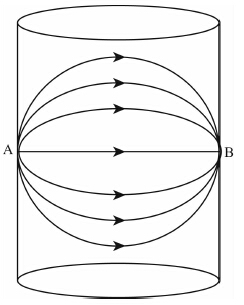 | 图 1 低频电磁波测量影响区域Fig. 1 Measured field of low-frequency electromagnetic wave |
设电磁场测量区域为Ω.在Ω内,介质电磁特性分布函数为μ(x,y,z).对于A点发射、B点接收的 情况,Ω内各点对信号的贡献量的分布函数为Cij(x,y,z,μ(x,y,z)),则测量信号可以表示为

式(1)实际上是把测量信号看作油井管道内各点电磁特性分布函数的加权和,而某点加权值的大小反映了测量值对该点介质变化的灵敏程度,空间内不同的点有不同的灵敏度,它构成了一个三维的敏感探测场.
电磁流动成像测井采用电偶极子激发3 MHz频率的信号,在直径仅十几厘米的油井套管中,可以认为电磁场为近区场(赵亮,2002):


近区场为准静态场,电场、磁场结构如图 2所示.
 | 图 2 电偶极子的近区场Fig. 2 Near-field of electric dipole |
在实际测量过程中,电磁流动成像测井主要任务是对油井中流体流动截面进行探测属于二维探测场问题,为了解决上述三维探测场干扰以及电磁“软场”问题,采用在油井轴向上屏蔽和径向上聚焦的方法,构建束状探测电磁场.2.1 轴向屏蔽方式
轴向上,在主电极的上下等间隔处安放两个相同的屏蔽电极如图 3所示,当主电极发射信号时,两 个屏蔽电极同时激发相同的信号,由于三个发射信号幅度、相位以及频率相同,使得测量区域内的电势在轴向上近似保持不变,即∂ E /∂z≈0,保证了主发射信号不会沿着井轴方向发散,而是被压制在一定的厚度范围内,且在一定的径向距离内保持不变.假设主电极长度为L,主电极与屏蔽电极间隔为M,则其测量区域在纵向上的厚度D为


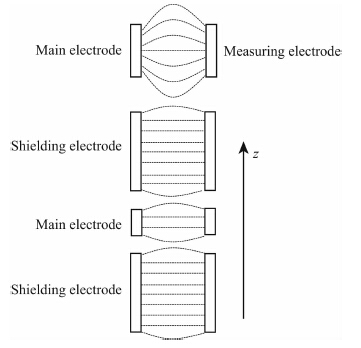 | 图 3 屏蔽敏感场的实现Fig. 3 Realization of shielding sensitivity field |
设一般情况下的测量区域为S如图 4,电流密度为J1,电场强度为E1,磁感应强度H1,则根据式(2)—(4)推导可得

 | 图 4 流动截面测量敏感场Fig. 4 Measured sensitivity field on the flow section |
对上述测量采用聚焦方式,当主电极发射信号时,其径向上的两个相邻电极同时激发相同的信号(图 5),接收电极左右两个相邻电极接地,由于三个 信号相同,使得主发射电极附近的径向测量区域内电势基本相同,从而抑制了主发射电磁信号的扩散,测量敏感区域被“聚焦”在一个束状狭长区域F内,F区域明显小于S区域;由于测量敏感区域的减小以及聚焦信号的叠加,F区域内的电力线和磁力线明显密集,测量信号势必增强.
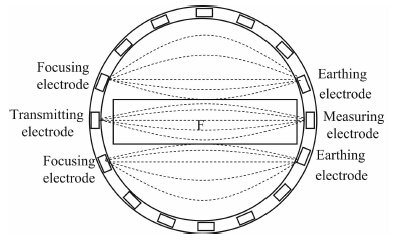 | 图 5 流动截面聚焦敏感场的实现Fig. 5 Realization of focusing sensitivity field on the flow section |
设聚焦后的测量区域为F,电流密度J2,电场强度为E2,磁感应强度H2,根据电磁场叠加原理可得到
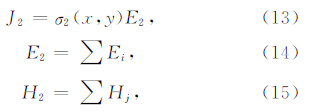
油井内的电磁场属于准静态情况下的时变电磁场,根据无旋场的性质,定义


建立笛卡儿坐标系如图 6所示,Z为井轴方向,XY平面为与井轴垂直.电磁流动成像测量的电磁场求解可分为纵向上ZX平面和横向上XY平面,其电势分布的定解问题为

 | 图 6 坐标系统Fig. 6 Coordinated system |
应用上述有限元计算方法,得到ZX平面上介质为纯空气情况下的无屏蔽与屏蔽两种电势分布以及测量电压幅度值,计算结果见图 7—9.由电势分布图 7和图 8对比可知,屏蔽与无屏蔽情况下ZX平面电势分布存在较大区别.屏蔽时,电势梯度沿X方向明显变小,整个平面内电势分布均匀,中间区域电势增大,接收电极附近的电势有所提高,根据测量信号仿真计算得知(图 9),屏蔽后测量信号增大30 mV左右;此外主发射电极与接收电极之间的电势分布沿Z方向变得平坦,即具有与X轴垂直的等电位线,电势不随Z的变化而变化.因此通过屏蔽 后,可以把三维探测电磁场问题近似归结为二维问题.
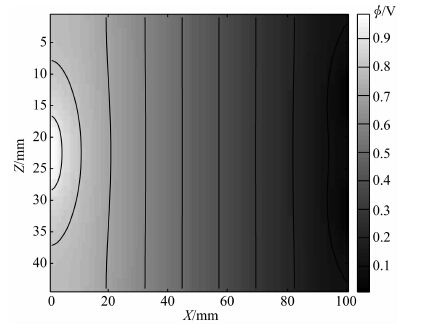 | 图 7 ZX平面无屏蔽电势分布Fig. 7 The potential distribution without shielding on the ZX plane |
 | 图 8 ZX平面屏蔽电势分布Fig. 8 The potential distribution by shielding on the ZX plane |
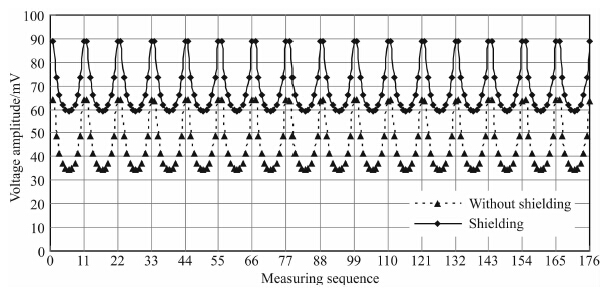 | 图 9 测量信号仿真计算对比图(无屏蔽和屏蔽)Fig. 9 The comparison diagram of the signal between without shielding and by shielding |
根据电磁传感器测量电极阵列的对称性,所有176种测量组合中只有6种典型的测量组合,其他测量组合均通过6种典型组合旋转一定角度获得(赵彦伟等,2007),如表 1所示.
| | 表 1 独立测量电极组合电极选择表 Table 1 Typical measure combination of poles |
以第6种组合为例对其进行仿真计算,得到XY平面上介质为纯空气情况下的无聚焦与聚焦两种电势分布以及测量电压幅度值,计算结果见图 10—12.由电势分布图 10和图 11对比可知,聚焦 时,整个XY平面内电势分布均匀,电势梯度明显减小,等势线平直,使得测量敏感区域主要集中在发射电极和接收电极之间的束状区域内;接收电极附近电势明显增强,根据测量信号仿真计算得知(图 12),聚焦后测量信号增大60 mV左右.
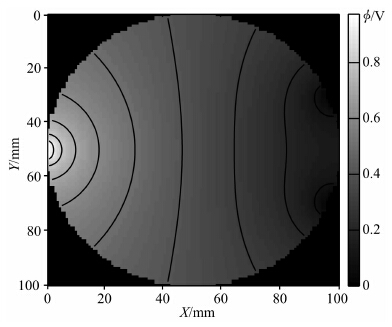 | 图 10 XY平面无聚焦电势分布Fig. 10 The potential distribution without focusing on the XY plane |
 | 图 11 XY平面聚焦电势分布Fig. 11 The potential distribution by focusing on the XY plane |
 | 图 12 测量信号仿真计算对比图(无聚焦和聚焦)Fig. 12 The comparison diagram of the signal between without focusing and by focusing |
根据敏感场计算函数(Fang,2004),以第6种组合为例,对其在无聚焦和聚焦情况下的测量敏感场进行仿真计算,结果见图 13和图 14.可以看出,无聚焦时,测量敏感区域主要集中在发射电极和接收电极附近,发射电极和接收电极之间的测量区域内敏感值几乎为零,电磁“软场”效应严重,接收电极附近敏感场杂乱,干扰较大;聚焦时,测量敏感区域不仅仅集中在发射电极和接收电极附近,在发射电极和接收电极之间的束状区域内也具有一定的敏感度,测量敏感区域呈马鞍状,接收电极附近敏感场均匀,受干扰较小.
 | 图 13 无聚焦下第6种组合敏感场X和Y轴表示划分网格的数量,Z轴表示敏感度,均无单位.Fig. 13 The sixth typical measure combination sensitivity field without focusing |
 | 图 14 聚焦下第6种组合敏感场X和Y轴表示划分网格的数量,Z轴表示敏感度,均无单位. Fig. 14 The sixth typical measure combination sensitivity field by focusing |
为了检验束状探测场特性,设计制作了阵列电磁传感器.模拟实验采用自主研发的电磁流动测井 实验仪,连接安捷伦公司生产的网络分析仪(E5061B)构成测量系统,在流动模拟管路上进行实验测量. 4.1 测量信号特征
实验介质采用空气和盐水,分别模拟天然气和地层水.其中盐水的电阻率为1 Ωm,采用幅值为1 V频率为3 MHz的正弦电压激励信号,功率为10 dBm.分别测量介质为全空气、50%空气-盐水以及全盐水情况下的电压幅度值,实验测量结果见图 15—17.结果表明,采用束状探测电磁场测量时的信号值最大,普通测量时的信号值最小,二者差距较大,且随着测量介质的电导率增加而增加,纯空气相差30 mV左右,纯盐水相差50 mV左右;另外其测量曲线的响应特征更符合实际规律,介质为纯空气纯盐水时,曲线光滑干扰少,形状呈“U”型变化,50%空气-盐水情况下,曲线的“台阶”特征明显,更易于判断和计算层流的相持率.
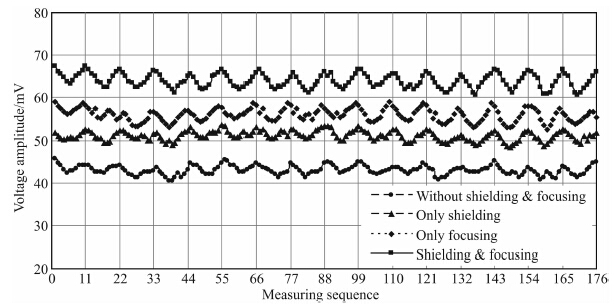 | 图 15 全空气测量信号对比图Fig. 15 The comparison diagram of the uniform air signal |
 | 图 16 50%空气-盐水测量信号对比图Fig. 16 The comparison diagram of the 50% gas-water stratified flow signal |
 | 图 17 全盐水测量信号对比图Fig. 17 The comparison diagram of the uniform saline water signal |
利用修正共轭梯度算法(别静等,2011)对50%空气-盐水介质的流动截面进行图像重建,所需数据均来自上述仿真计算和实验测量,重建后图像见图 18.可看出,采用束状探测电磁场测量时,重建的流动截面图像清晰可见,50%空气-盐水分界 面明显,成像质量明显提高,并且在图像重建过程中,成像速度明显加快;普通测量所得的图像模糊不清,失真严重.
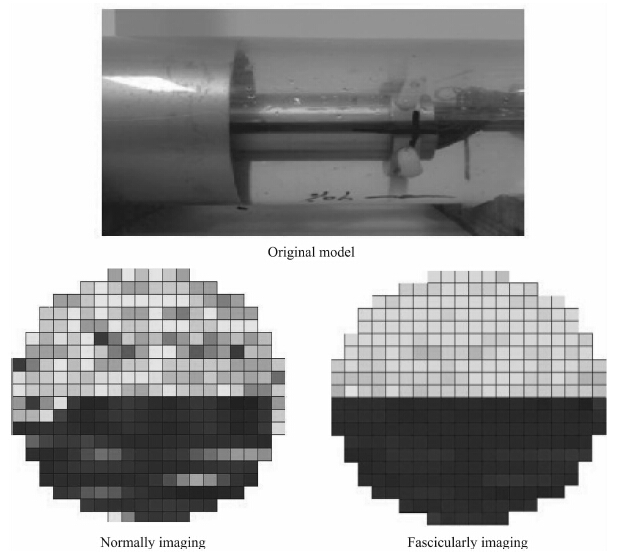 | 图 18 50%空气-盐水成像对比图Fig. 18 The comparison images of the 50% gas-water stratified flow signal |
(1)油井流动成像电磁测量采用井轴方向屏蔽和井径方向聚焦的方法可以构建束状探测电磁场;
(2)束状探测电磁场可以增强流动截面中间测 量区域的敏感性,有效抑制了电磁测量的“软场”效应;
(3)电磁测量实验结果表明,束状探测电磁场可以增强物场的测量信号,提高流动截面的图像重建质量.
| [1] | Bi D X. 1985. Electromagnetic Field Theory (in Chinese). Beijing: Electronic Industry Press. |
| [2] | Bie J, Wu X L, Miao Z W. 2011. Study on flowing image reconstruction algorithms for oil wells. Journal of Oil and Gas Technology (in Chinese), 33(7): 92-94. |
| [3] | Cao Z, Wang H, Yang W Q, Yan Y. 2007. A calculable sensor for electrical impedance tomography. Sensors and Actuators A,140: 156-161. |
| [4] | Fang W F. 2004. A nonlinear image reconstruction algorithm for electrical capacitance tomography. Meas. Sci. Technol., 15(10): 2124-2132. |
| [5] | Hanke M, Bruhl M. 2003. Recent progress in electrical impedance tomography. Inverse Prob., 19: S65-S90. |
| [6] | Sardarinejad A, Maurya D K, Alameh K. 2014. The effects of sensing electrode thickness on ruthenium oxide thin-film pH sensor. Sensors and Actuators A, 214: 15-19. |
| [7] | Wu X L, Jing Y Q, Wu S Q. 1999. Electromagnetic imaging logging method in multiphase pipe flow. Chinese J. Geophys. (in Chinese), 42(4): 557-563. |
| [8] | Zhang X Z. 1998. Flow pattern reconstruction based on the theory of electromagnetic flow measurement. Acta Metrological Sinica (in Chinese), 1998,19(1):39-43. |
| [9] | Zhao L. 2002. Study on flow imaging logging using electromagnetic wave [Ph. D. thesis](in Chinese). Beijing: China University of Petroleum. |
| [10] | Zhao Y W, Wu X L, Wang X X. 2007. Simulation of sensitivity field for electromagnetic tomography in multiphase flow well logging. Chinese J. Geophys. (in Chinese), 50(3): 946-950. |
| [11] | 毕德显. 1985. 电磁场理论. 北京:电子工业出版社. |
| [12] | 别静, 吴锡令, 缪志伟. 2011. 油井流动图像重建算法研究. 石油天然气学报, 33(7): 92-94. |
| [13] | 吴锡令, 景永奇, 吴世旗. 1999. 多相管流电磁成像测井方法研究. 地球物理学报, 42(4): 557-563. |
| [14] | 张小章. 1998. 基于流动电磁测量理论的流场重建. 计量学报, 19(1): 39-43. |
| [15] | 赵亮. 2002. 电磁波流动成像测井方法研究[博士论文]. 北京: 中国石油大学. |
| [16] | 赵彦伟, 吴锡令, 王晓星. 2007. 油井多相流电磁成像测量敏感场仿真. 地球物理学报, 50(3): 946-950. |
 2015, Vol. 58
2015, Vol. 58


